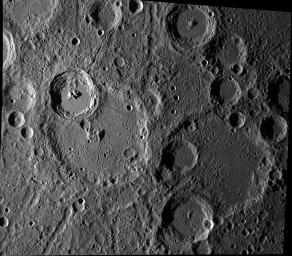The Interior of Kuiper
Caption:
The rayed crater Kuiper (11.3° S, 328.6° E), as seen by MESSENGER's wide-angle camera. The smooth regions on Kuiper's floor and to its south consist of rock that was melted by the impact that created the crater. This impact melt ponded and solidified as smooth plains. Kuiper is 62 km in diameter and is an important stratigraphic marker in Mercury's geologic history.
This image was acquired as part of MDIS's high-resolution surface morphology base map. The surface morphology base map will cover more than 90% of Mercury's surface with an average resolution of 250 meters/pixel (0.16 miles/pixel or 820 feet/pixel). Images acquired for the surface morphology base map typically have off-vertical Sun angles (i.e., high incidence angles) and visible shadows so as to reveal clearly the topographic form of geologic features.
Date acquired:
May 04, 2011
Image Mission Elapsed Time (MET):
212983376
Image ID:
210557
Instrument:
Wide Angle Camera (WAC) of the Mercury Dual Imaging System (MDIS)
WAC filter:
7 (748 nanometers)
Center Latitude:
-12.33°
Center Longitude:
331.2° E
Resolution:
309 meters/pixel
Scale:
Kuiper is 62 km (39 miles) in diameter
Incidence Angle:
78.1°
Emission Angle:
28.0°
Phase Angle:
106.1°
Background Info:
These images are from MESSENGER, a NASA Discovery mission to conduct the first orbital study of the innermost planet, Mercury. For information regarding the use of images, see the MESSENGER
image use policy
.
Cataloging Keywords:
| Name |
Value |
Additional Values |
| Target |
Mercury |
|
| System |
|
|
| Target Type |
Planet |
|
| Mission |
MESSENGER |
|
| Instrument Host |
MESSENGER |
|
| Host Type |
Orbiter |
|
| Instrument |
Mercury Dual Imaging System (MDIS) |
|
| Detector |
Wide Angle Camera (WAC) |
|
| Extra Keywords |
Crater, Grayscale, Impact, Map, Shadow |
| Acquisition Date |
|
| Release Date |
2011-10-05 |
| Date in Caption |
2011-05-04 |
|
| Image Credit |
NASA/JPL-Caltech/University of Arizona |
| Source |
photojournal.jpl.nasa.gov/catalog/PIA14863 |
| Identifier |
PIA14863 |

 Planetary Data System
Planetary Data System
